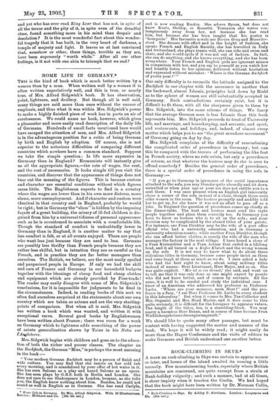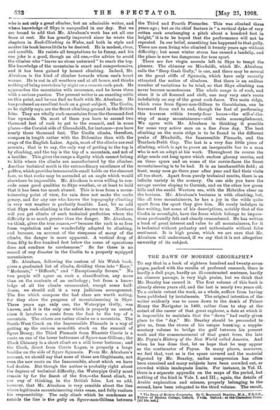ROCK-CLIMBING IN SKYE.* A Boon on rock-climbing in Skye was
certain to appear sooner or later, and lovers of the island awaited its coming a little uneasily. Few mountaineering books, especially where British mountains are concerned, are quite exempt from a strain of Bank-holiday vulgarity ; and such a manner, bad at all times, is sheer impiety when it touches the Coolin. We had hoped that the book might have been written by Dr. Norman Collie,
Beck.CLimbing in Skye. By Ashley P. Abraham. London : Longmana and Co. Pia. net. J who is not only a great climber, but an admirable writer, and whose knowledge of Skye is unequalled in our day. But we are bound to add that Mr. Abraham's work has set all our fears at rest. He has greatly improved since he wrote the chapters in Rock-Climbing in Wales, and both in style and matter his book leaves little to be desired. He is modest, clear, and sensible. He resists all temptations to be funny, and his one joke is a good, though an old one,—the advice to avoid the climber who "leaves no stone unturned" to reach the top. His knowledge of the mountains is exact and comprehensive, and it has been gained by honest climbing. Indeed, Mr. Abraham is the kind of climber towards whom one's heart warms. He is out in all weathers and at all hours, and thinks nothing of being overtaken by night on a remote rock-peak. He approaches the mountains with reverence, and he loves them with a serious passion. The present writer is an exacting critic on this point, and he can find no fault with Mr. Abraham. He has producedan excellent book on a great subject. The Coolin, as he rightly says, are the finest climbing-ground in the British Isles. They are wholly rock-mountains from the thousand-feet line upwards. On most of them you have to ascend two thousand feet of rock to get to the summit, and in some places—the Coruisk side of G-hreadaidh, for instance—you have nearly three thousand feet. The Coolin climbs, therefore, compare in length rather with the Dolomites than with the crags of the English Lakes. Again, most of the climbs are real ascents ; that is to say, the only way of getting to the top is by climbing, and the top is the top of a mountain, and not of a boulder. This gives the range a dignity which cannot belong to hills where the climbs are manufactured by the climber. Another technical merit is the extraordinary excellence of the gabbro, which provides innumerable small holds on the sheerest face, so that racks may be ascended at an angle which would elsewhere be impossible. Mr. Abraham is even willing to con- cede some good qualities to Skye weather, or at least to hold that it has been too much abused. This is true from a moun- taineering point of view, for rain does not make the rocks greasy, and for any one who knows the topography climbing in very wet weather is perfectly feasible. Last, let us add that Skye rock-climbing is the safest known to us. Nowhere will you get climbs of such technical perfection where the difficulty is so much greater than the danger. Mr. Abraham, we think, gives the true reason,—" because the rock is so free from vegetation and so wonderfully adapted to climbing, and because, on account of the steepness of many of the climbs, the danger is more apparent. A vertical drop of from fifty to five hundred feet below the scene of operations does not conduce to carelessness." So far there is no record of any disaster in the Coolin to a properly equipped mountaineer.
Mr. Abraham, following the custom of his Welsh book, gives a graduated list of climbs, dividing them into " Easy," " Moderate," "Difficult," and " Exceptionally Severe." No two people will agree on such a classification, any more than on the contents of an anthology ; but from a know- ledge. of all the climbs enumerated, except some half- iozen, we should call it a very judicious arrangement. The five which compose the last class are worth noting, for they show the progress of mountaineering in Skye. Three years ago only one, the Waterpipe Gully, was known, and it is the only one which is properly an ascent, since it involves a route from the foot to the top of a mountain. The others are rather climbs on a mountain. The South-West Crack on the Inaccessible Pinnacle is a way of getting up the curious monolith stuck on the summit of Sgurr Dearg; the Third Pinnacle from Bhasteir Corrie is a route On one of the lower buttresses of Sgurr-nan-Gillean ; the Black Chimney is a short climb on a still lower buttress ; and the Cioch, direct from Corrie Lagan, is properly a large boulder on the side of Sgurr Sgumain. From Mr. Abraham's account, we should say that none of these are illegitimate, not even the new route on the Inaccessible, about which we have bad doubts. But though the author is probably right about the degrees of technical difficulty, the Waterpipe Gully must remain by far the finest of the five,—the finest climb, to our way, of thinking, in the British Isles. Let us add, however, that Mr. Abraham is very sensible about the line wherelegitimate mountaineering risks cease, and fully realises his responsibility. The only climb which he condemns- as outside the line is the gully on • Sgurr-naw-Gillean between the Third and Fourth Pinnacles. This was climbed three years ago; but as its chief feature is." a vertical dyke of very rotten rock overhanging a pitch about a hundred feet in height," it is to be hoped that the performance will not be repeated. In our belief, something has happened to that gully. There are men living who climbed it twenty years ago without difficulty; but some winter, storm has caused a landslip, and the place is now too dangerous for true sport.
There are few virgin ascents left in Skye to tempt the- pioneer. The chimney on Mhadaidb, which Mr. Abraham calls the "Deep Gash Gully," is one, and there may be several. on the great cliffs of Sgnmain, which have only recently attracted the notice of climbers. But there is an endless number of variations to be tried, so that Skye climbing can never become monotonous. The whole range is of rock, and since it is all fissured and cleft, one may vary one's route indefinitely on any of the great rock-faces. The main ridge, which runs from Sgurr-nan-Gillean to Garsbhainn, can be- traversed from end to end, though the feat of performing this traverse within twenty-four hours—the will-o'-the- wisp of many mountaineers—still waits accomplishment. We agree with Mr. Abraham in thinking it possible• for some very active man on a fine June day. The best climbing on the main ridge is to be found in the different peaks of Mbadaidh, the Inaccessible. Pinnacle, and the Tearlach-Dubh Gap. The last is a very, fine little piece of" climbing, which is apt to prove an insuperable bar to a man who is not an adept at his work. Throughout its course the ridge sends out long spurs which, enclose gloomy corries, and- on these spurs and on some of the corrie-faces the finest. mountaineering is to be had. It is an inexhaustible field ; at. least, many men go there year after year and find their visits-- all too short. Apart from purely technical merits, there is an infinite variety in the scenery. On one side you have the- savage corries sloping to Cornisk, and on the other low green hills and the sunlit Western sea, with the Hebrides clear on the horizon. Mr. Abraham's business is with climbing, but,. like all true mountaineers, he has a joy in the wilds quite- apart from the sport they give him. He rarely indulges in. fine writing, but some of his descriptions, notably that of the- Coolin in moonlight, have the force which belongs to impres- sions profoundly felt and clearly remembered. He has written. a book of great interest and value to all mountaineers, for it is technical without pedantry and enthusiastic without false- sentiment. It is high praise, which we are sure that Mr.. Abraham will understand, if we say that it is not altogether- unworthy of its subject.







































 Previous page
Previous page